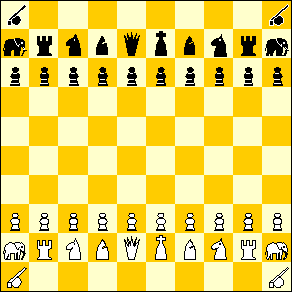Shako
Inspired by several old chess variants, Jean-Louis Cazaux from Toulouse (France) invented this variant. The name Shako means Chess in Esperanto, `another kind of non-conformism and utopia', in the words of the inventor. The idea of this variant is to make a new game without directly disposing the large heritage of the classical game. All rules of orthodox chess are kept, and the way the pieces are placed in the opening setup allow players to follow practical all the openings used for orthodox chess. The new pieces are taken from Xiangqi (Chinese Chess), with the intention to bring back together the two branches of the game that went of from India either east to the Orient, and west to the Arabs.
Rules
 White:
White:
King f2; Queen e2; Rook b2, i2; Knight c2, h2; Bishop d2, g2; Elephant
a2, j2; Cannon a1, j1, Pawn a3, b3, c3, d3, e3, f3, g3, h3, i3, j3, k3,
l3.
Black:
King f9; Queen e9; Rook b9, i9; Knight c9, h9; Bishop d9, g9; Elephant
a9, j9; Cannon a10, j10; Pawn a8, b8, c8, d8, e8, f8, g8, h8, i8, j8, k8,
l8.
Movement of pieces and other rules
Elephants move one or two squares diagonally. When an elephant moves two squares, it is allowed to jump, i.e., the intervening square does not have to be empty.
Cannons move without taking like rooks, and they move with taking by going in a straight horizontal and vertical line and jumping over exactly one piece: when a cannon takes a piece, there must be exactly one piece between the original and final square of the cannons move - this piece may be of either color. (This is identical to the move of the cannon in Xiangqi.)
All other pieces move like in orthodox chess; also castling is as in usual chess. Pawns promote on the tenth row of the board to Queen, Rook, Knight, Bishop, Elephant, or Cannon, to the owning players choice.
Other rules are as in orthodox chess.
Comments
You can download:- Set of bitmaps of the pieces that are used in Shako. By Jean-Louis Cazaux.

Cazaux adds with his submission to the contest the following comments.
In this contest, Shako belongs to a sub-category of Decimal Chess which is very popular probably because the board is easily available from International Draughts. I consider that its strongest points are:
- Respect of the internal arrangement of the Orthodox pieces which makes it familiar even for the fresh player. Main FIDE chess principles are therefore still valid: openings, etc.
- Introduction of two new pieces, both kind of leapers, one orthogonal, one diagonal which is a balanced choice. The orthogonal is the well known Xiang-Qi Cannon while the diagonal is a "modernization" of the old Alfil. I noticed that these two points are also endorsed by many more recent CV, apparently with no direct inspiration between each other. I'm pretty happy of that, it shows that we are on the good way.
Written by Hans Bodlaender, based on a French text by Jean-Louis Cazaux, and comments by Jean-Louis Cazaux.
This variant is an entry in the 1999 Large Variant contest.
WWW page created: October 21, 1997. Last modified: March 13, 1999.
